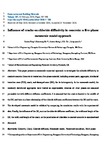Influence of cracks on chloride diffusivity in concrete: a five-phase 6 mesoscale model approach
| dc.contributor.author | Li, Long-yuan | |
| dc.date.accessioned | 2018-12-05T15:41:30Z | |
| dc.date.issued | 2019-02-10 | |
| dc.identifier.issn | 0950-0618 | |
| dc.identifier.issn | 1879-0526 | |
| dc.identifier.uri | http://hdl.handle.net/10026.1/12992 | |
| dc.description.abstract |
This paper presents a mesoscale numerical approach to investigate the chloride diffusivity in cracked concrete. Concrete is treated as a five-phase material, including cement paste, aggregate, interfacial transition zone (ITZ), crack, and damaged zone (DZ), for its heterogeneity. In the mesoscale model, the randomly distributed aggregates were treated as impermeable, whereas all other phases are assumed permeable but with different diffusion coefficients. It is assumed that the crack is located in the middle of the DZ, and there is a liner relationship of the chloride diffusion coefficients between the DZ and the crack. The developed mesoscale model is validated by comparing the simulation results with the experimental data. Finally, the influence of the DZ, such as the chloride diffusion coefficient, the width and length of the DZ, the width and length of the crack, on the penetration of chlorides in cracked concrete is examined and discussed. | |
| dc.format.extent | 587-596 | |
| dc.language | en | |
| dc.language.iso | en | |
| dc.publisher | Elsevier | |
| dc.subject | Concrete | |
| dc.subject | Crack | |
| dc.subject | Chloride diffusion | |
| dc.subject | Mesoscale model | |
| dc.subject | Numerical simulation | |
| dc.subject | Multi-phase | |
| dc.title | Influence of cracks on chloride diffusivity in concrete: a five-phase 6 mesoscale model approach | |
| dc.type | journal-article | |
| dc.type | Journal Article | |
| plymouth.author-url | https://www.webofscience.com/api/gateway?GWVersion=2&SrcApp=PARTNER_APP&SrcAuth=LinksAMR&KeyUT=WOS:000457951100056&DestLinkType=FullRecord&DestApp=ALL_WOS&UsrCustomerID=11bb513d99f797142bcfeffcc58ea008 | |
| plymouth.volume | 197 | |
| plymouth.publication-status | Published | |
| plymouth.journal | Construction and Building Materials | |
| dc.identifier.doi | 10.1016/j.conbuildmat.2018.11.208 | |
| plymouth.organisational-group | /Plymouth | |
| plymouth.organisational-group | /Plymouth/Faculty of Science and Engineering | |
| plymouth.organisational-group | /Plymouth/Faculty of Science and Engineering/School of Engineering, Computing and Mathematics | |
| plymouth.organisational-group | /Plymouth/REF 2021 Researchers by UoA | |
| plymouth.organisational-group | /Plymouth/REF 2021 Researchers by UoA/UoA12 Engineering | |
| plymouth.organisational-group | /Plymouth/Research Groups | |
| plymouth.organisational-group | /Plymouth/Research Groups/Marine Institute | |
| plymouth.organisational-group | /Plymouth/Users by role | |
| plymouth.organisational-group | /Plymouth/Users by role/Academics | |
| dcterms.dateAccepted | 2018-11-23 | |
| dc.rights.embargodate | 2019-11-30 | |
| dc.identifier.eissn | 1879-0526 | |
| dc.rights.embargoperiod | Not known | |
| rioxxterms.versionofrecord | 10.1016/j.conbuildmat.2018.11.208 | |
| rioxxterms.licenseref.uri | http://www.rioxx.net/licenses/all-rights-reserved | |
| rioxxterms.licenseref.startdate | 2019-02-10 | |
| rioxxterms.type | Journal Article/Review |


